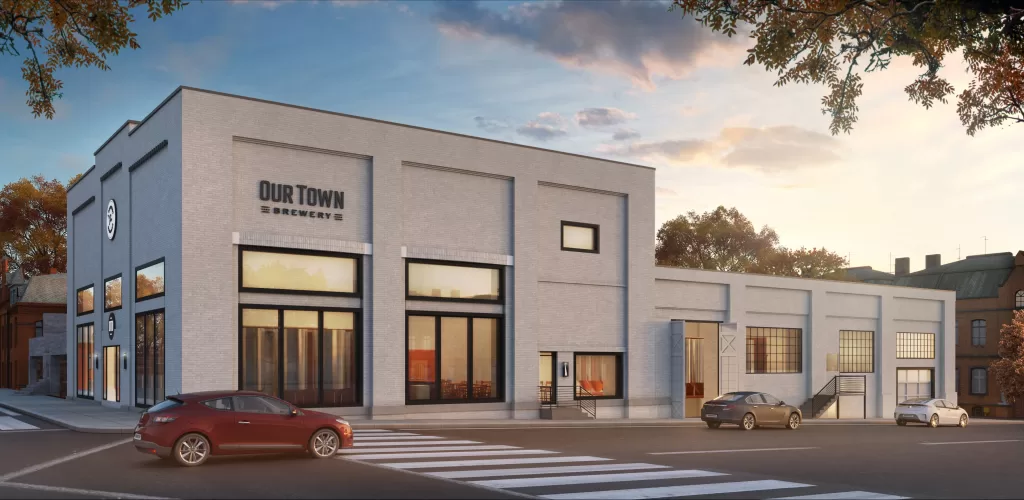
Rendering for Our Town Brewery created by Henrietta Heisler Interiors Inc.
Restaurant interior design plays a crucial role in creating a memorable dining experience for customers. It goes beyond just aesthetics; it sets the mood, enhances comfort, and reflects the brand’s identity. Whether you’re opening a new restaurant or revamping an existing space, understanding the dos and don’ts of restaurant interior design is essential. In this comprehensive guide, we’ll explore the key elements of successful restaurant interior design, from establishing a theme to considering lighting, layout, color psychology, and more. Discover how to create an ambiance that leaves a lasting impression on your guests.
Table of Contents
- Establishing a Theme
- Harnessing the Power of Lighting
- Optimizing the Layout
- Creating Comfortable Seating
- Incorporating Natural and Organic Elements
- Taking Advantage of Color Psychology
- Using Artwork to Connect with the Community
- The Importance of Restroom Design
- Seeking Professional Help
- Local Restaurant Interior Design Examples
1. Establishing a Theme
When it comes to restaurant interior design, establishing a theme is crucial. A well-executed theme sets the tone for your restaurant and helps create a cohesive and immersive experience for your guests. Whether you opt for a timeless and elegant theme or a more contemporary and trendy concept, the theme should align with your menu and target audience.
Consider the goth theme our company assisted in designing, The Coffin Bar. This restaurant is located in Lancaster city, Pa. This mysterious restaurant successfully infuses an dark eerie touch through the use of dark colors, irreverent décor, and eclectic food. The theme should be carefully chosen to withstand the test of time and appeal to your target market.
2. Harnessing the Power of Lighting
Lighting is a key element in restaurant interior design as it sets the mood and ambiance of the space. The right lighting can enhance the dining experience and influence customer behavior. Consider the type of environment you want to create and choose your lighting accordingly.
High-contrast lighting with low brightness creates a calming and intimate effect, ideal for fine dining establishments. In contrast, low-contrast lighting with high brightness creates a more energetic vibe, suitable for casual and fast-casual restaurants. Direct lighting above tables is essential for showcasing beautifully plated dishes, while overhead lighting can highlight wall art and decor.
3. Optimizing the Layout
The layout of your restaurant plays a significant role in the overall dining experience. An open floor plan can foster a sense of community and connection between guests and staff. Consider incorporating an open-facing kitchen that allows guests to witness the food preparation process, adding authenticity to the dining experience.
Glass walls can be used to connect outdoor dining areas with the rest of the space, creating inclusivity. Strategic seating arrangements can create intimacy while maintaining a communal atmosphere. Thoughtful consideration of the layout ensures that guests can comfortably navigate the space and engage with the restaurant’s offerings. We offer drawing renderings (as you see above) to allow you to see how the space will look.
4. Creating Comfortable Seating
Comfortable seating is essential for ensuring a pleasant dining experience. Adequate spacing between tables allows guests to have private conversations and move around comfortably. Strike a balance between maximizing seating capacity and providing sufficient elbow room for guests. Our company assists in detailed measurements to ensure comfortable room to move about.
Consider different table sizes to accommodate various group sizes. Two or three-person tables work well for intimate settings, while larger tables are necessary for accommodating groups. Flexibility in table layouts allows for versatility in accommodating different party sizes and occasions.
5. Incorporating Natural and Organic Elements
Bringing natural and organic elements into your restaurant design adds warmth, texture, and visual interest. Incorporate hanging plant baskets, exotic flora boxes, and flower arrangements for bar and table decor. Large trees, such as palms or figs, can serve as statement pieces, adding dimension to the space.
Consider incorporating a living wall as a natural divider or focal point in the foyer. This not only adds visual appeal but also signifies your commitment to sustainability. By incorporating natural and organic elements, you create a vibrant and inviting space that resonates with your guests.
6. Taking Advantage of Color Psychology
Color psychology plays a significant role in influencing customer behavior and setting the desired mood in a restaurant. Different colors evoke different emotions and can impact appetite, productivity, and overall experience.
Consider warm and muted colors like terracotta, Tuscan yellow, and ochre for a conventional and comfortable ambiance. These colors create a cheerful and inviting space. Green is a trendy choice that promotes a sense of freshness and health, making it suitable for upscale restaurants.
Blue and purple can be used as accents in lounges and bars but should be used sparingly in restaurants serving full-course meals, as they may destimulate the appetite. Understanding color psychology allows you to create a customized ambiance that aligns with your brand and enhances the dining experience.
7. Using Artwork to Connect with the Community
Artwork adds a personal touch to your restaurant interior design and can help create a unique and memorable experience. Select art that complements your restaurant’s theme and contributes to the desired atmosphere.
Consider murals, portraits, photography, sculptures, or graffiti that align with your overall aesthetic. This is an excellent opportunity to support local artists and showcase their work. Artwork not only adds visual interest but also creates a connection with the community and communicates your brand’s values.
8. The Importance of Restroom Design
While often overlooked, restroom design is a critical aspect of restaurant interior design. Restrooms should be comfortable, clean, and visually appealing. Depending on the size of your restaurant, you can choose between stall-style restrooms or regular ones, ensuring adequate lighting and color schemes that are consistent with the overall design.
Premium materials like granite, quartz, and hardwoods can elevate the restroom’s aesthetic, while plush seating arrangements enhance comfort. Paying attention to restroom design ensures that every aspect of the dining experience is considered and reflects the restaurant’s commitment to quality.
9. Seeking Professional Help
Designing a restaurant interior can be a complex and time-consuming process. Seeking the assistance of professional interior designers can make a significant difference in the outcome. Experienced designers understand the nuances of restaurant interior design and can bring your vision to life effectively.
Working with professionals allows you to benefit from their expertise and industry connections. They can guide you through the design process, help you make informed decisions, and ensure that your restaurant interior design aligns with your brand image and goals.
10. Local Restaurant Interior Design Examples
Looking for inspiration from successful local restaurants we helped interior designs in Lancaster, PA? Here are a few examples of our projects:
- Root: This cozy farm-to-table restaurant embraces a rustic and earthy aesthetic, with exposed brick walls, reclaimed wood furniture, and warm lighting. The use of natural materials creates a warm and inviting atmosphere that reflects the restaurant’s commitment to sustainability.
- Own Town Brewery: The brewery exudes a dynamic atmosphere, where visitors can witness the brewing process firsthand and feel immersed in the energy of the space. This interactive element adds an extra layer of excitement to your visit, allowing you to fully appreciate the craftsmanship that goes into every batch of beer we produce.
- The Coffin Bar: The Coffin Bar is unlike any other place you’ve seen before. It’s eccentric, intimate, and fearlessly fresh. We wanted to create a space where people could come together and enjoy not only great craft beer but also delicious comfort food that changes with the seasons. Our menu features approachable dishes that cater to a wide range of palates.
These local examples demonstrate the importance of tailoring restaurant interior design to the target audience and brand identity. By drawing inspiration from successful local designs, you can create a unique dining experience that resonates with your customers.
In conclusion, restaurant interior design is a critical aspect of creating an unforgettable dining experience. By establishing a theme, harnessing the power of lighting, optimizing the layout, creating comfortable seating, incorporating natural and organic elements, using color psychology, showcasing artwork, paying attention to restroom design, seeking professional help, and drawing inspiration from local designs, you can create a space that leaves a lasting impression on your guests. Remember, every element of your restaurant interior design should reflect your brand’s identity and contribute to the overall ambiance.
Opening a restaurant? Give us a call to discuss your vision, and see if we may be a good fit to help your idea come to life! Fill out the contact form.







